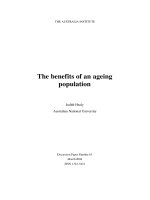Don’t stop me now Preparing for an ageing population pot
Bạn đang xem bản rút gọn của tài liệu. Xem và tải ngay bản đầy đủ của tài liệu tại đây (712.6 KB, 76 trang )
Don’t stop
me now
Preparing for an ageing population
Local government
National report
July 2008
The Audit Commission is an independent watchdog, driving economy,
efciency and effectiveness in local public services to deliver better
outcomes for everyone.
Our work across local government, health, housing, community safety
and re and rescue services means that we have a unique perspective.
We promote value for money for taxpayers, covering the £180 billion
spent by 11,000 local public bodies.
As a force for improvement, we work in partnership to assess local public
services and make practical recommendations for promoting a better
quality of life for local people.
© Audit Commission 2008
For further information on the work of the Commission please contact:
Audit Commission, 1st Floor, Millbank Tower, Millbank, London SW1P 4HQ
Tel: 020 7828 1212 Fax: 020 7976 6187 Textphone (minicom): 020 7630 0421
www.audit-commission.gov.uk
Contents
Summary 6
England’s population is ageing 6
Few councils are successfully creating an environment in which
people thrive as they age 6
All councils should work with older people to age-proof
mainstream services 7
Councils should target services to tackle social isolation and
support independent living 7
Recommendations 8
Introduction 9
Chapter 1 11
A diverse ageing population 11
The ageing population 11
Increased diversity 16
Overcoming stereotyping 16
Opportunities and challenges 19
Chapter 2 20
Policy and performance 20
Local preparedness for an ageing population 21
Experiences of older people 24
Measuring spend and evaluating outcomes 25
Impact of Opportunity Age on local strategies and performance 29
A broad role for an ageing population; community leadership and
value for money services 32
Contents Don’t stop me now 3
Contents
Chapter 3 35
Understanding and engaging the older community 35
Understanding the community 35
Key characteristics of good engagement 38
Good engagement - a cross-cutting process 38
Good engagement - an effective lead champion for older people 40
Good engagement - driving improvement 42
Good engagement - monitoring outcomes 45
Good engagement - a process that evolves and improves 46
Mobilising the community 47
Understanding, engaging and mobilising the community checklist 50
Chapter 4 51
Age-proong mainstream services 51
Equal access for an older population 51
Involving older people in planning from the outset 51
Designing core services that all older people can use 52
Using existing resources wisely to improve access to services 53
Adapting mainstream services for older age groups 55
Taking innovative approaches to improving essential services
delivered by others 56
Age-proong checklist 57
4 Contents Don’t stop me now
Contents Don’t stop me now 5
Chapter 5 58
Targeted services that promote independence 58
Services tailored to the community 58
Developing resource centres as community hubs 59
Help with essential repairs and small jobs 61
Working with health partners to deliver interventions 63
Making use of technology 67
Innovative solutions for complex problems 67
Targeted Services Checklist 69
Chapter 6 70
Looking forward 70
Understanding and engaging the community is essential 70
Councils need to improve evaluation 70
Central government needs to provide clear guidance and set
outcomes 71
The Audit Commission will provide tools and utilise the lessons from
this study 71
Appendix 1 – Methodology 72
Appendix 2 – External Advisory Group 73
Appendix 3 – References 74
Summary
6 Summary Don’t stop me now
England’s population is ageing
• Councils have a local area leadership role to ensure that older people can live
independently and actively, with a good quality of life, for as long as possible.
• As the population ages, the challenges and opportunities differ between areas;
each council must lead an appropriate local response.
• The ageing population will be increasingly diverse: stereotypes about older
people are misleading, so councils need information about the diversity of their
local people.
• Older people - as citizens, volunteers, and service users - are an important
resource for local action to tackle social isolation and support independent
living.
Most councils should do more to create an environment in which people
thrive as they age
• Central government’s Opportunity Age initiative to improve the quality of life of
all older people has had limited impact.
• Only a third of councils are well prepared for an ageing population, though a
further third are making progress.
• The vigour of local action by councils is often not determined by the extent of
local need.
• Older people experience councils as organisations that view them in terms of
care needs, with little focus on diversity and opportunities.
• All councils need to understand their older communities and shape both
universal and targeted services accordingly.
• Increased awareness, better engagement and innovation could help many
older people without signicant expenditure.
All councils should work with older people to age-proof mainstream
services
• Councils need to engage with older people in commissioning, designing, and
delivering both mainstream and targeted services.
• Older people’s champions and representative boards can play an important
role in assessing and evaluating the effect of local services on older people’s
lives.
• Councils can deliver signicant benets from age-proong mainstream
services, often at low cost.
• Age-proofed mainstream services provide benets for other members of the
local community, including people with disabilities and parents with young
children.
• Marketing and promoting existing services to older people can increase take-
up and support independent lives.
• The best councils innovate to adapt mainstream services for older people and
work with public and private sector partners to drive improvements.
Councils should target services to tackle social isolation and support
independent living
• Targeted services should focus on the underlying causes of dependency in
later life.
• Councils should lead local statutory agencies and the community and voluntary
sector in making the most effective use of local resources.
• There are many older people ready and willing to contribute to community life:
local authorities and their partners should mobilise this resource.
Summary Don’t stop me now 7
Recommendations
1 Local councils should:
• review their local demographic proles
and reassess their approach to the
ageing population;
• identify how they can work with older
people and local partners to make more
efcient use of public and community
resources;
• link local demographic proles and
community needs in age-proong
mainstream services and designing
targeted services;
• tackle stereotypes and myths that
prevent older people being fully
engaged in the community and receiving
appropriate services;
• target spending to have the most impact
and improve evaluation; and
• use this study to support a management
review, or councillor scrutiny, of support
for well-being in later life.
2 Central government should:
• use the experience of Every Child
Matters to review and strengthen the
approach of Opportunity Age, working
with councils to design a clear outcome-
focused framework; and
• formulate and monitor policy by using
appropriate third sector organisations as
a voice for older people.
3 Audit Commission will:
• work with other inspectorates to
use the lessons from this study in
Comprehensive Area Assessment
methodologies; and
• work with key partners, including the
Department for Work and Pensions
(DWP), the Local Government
Association, Improvement and
Development Agency (IDeA), Age
Concern, and Help the Aged to
disseminate the good practice
highlighted in this study.
8 Recommendations Don’t stop me now
Introduction
4 England’s population is ageing and the
trend is accelerating. This is a signicant
demographic change that has not been
seen before. The change brings both
opportunities and challenges and there is a
need for councils to make an independent
life an option to as many people as possible,
for as long as possible. Councils need to
start planning for an ageing population to
ensure that the risks are minimised and that
opportunities are maximised.
5 This study focuses on people aged 50
and over; specically people who are living
independently and do not have a need for
social care services.
6 The years between 50 and 65 are a
transitional period for many people, with
numerous life-changing events. Many of
these changes are positive and bring with
them new or renewed opportunities. Other
changes are less positive and can reduce
choice and independence. Local services
need to have a focus on this transitional
period in life, as well as on older age groups,
to ensure that appropriate services and
interventions are in place for those who need
them.
7 This study aims to help local public services
adapt to the needs of an older and more
diverse society. It identies solutions that
can be implemented quickly and explores
how councils should plan strategically for the
wider challenges ahead.
8 Research for this study took place in autumn
2007 and winter of 2007/08.The Audit
Commission interviewed 235 people in tenI
local authorities, four older people mystery
shopped 49 councils, and 175 older people
took part in 15 focus groups. Details of
the study methodology can be found in
Appendix 1.
9 The key messages from the study are:
• the population is ageing and the older
population is becoming more diverse;
• few councils are well prepared for the
additional diversity in their populations;
• central government’s Opportunity Age
initiative has had limited impact;
• councils have a local leadership role to
create an environment in which people
can maintain a good quality of life as they
age;
• all councils need to understand
their older communities and shape
both universal and targeted services
accordingly; and
• increased awareness, better engagement
and innovation could help many older
people without signicant expenditure.
I The ten councils selected represented a range of performance, council type, area type (rural and urban) and proportion of
older people (now and projected).
Introduction Don’t stop me now 9
10 This report has six chapters:
• Chapter 1 - a diverse ageing population;
• Chapter 2 - policy and performance;
• Chapter 3 - understanding and engaging
the older community;
• Chapter 4 - age-proong mainstream
services;
• Chapter 5 - targeted services that
promote independence
• Chapter 6 - looking forward.
10 Introduction Don’t stop me now
11 Practical advice is available to download
from the Audit Commission website that
includes:
• animated maps that illustrate population
change across England between 2009
and 2029;
• checklists for councils;
• a tool to help councils use information
more effectively when designing services
for an older population;
• a mystery shopper survey methodology;
and
• case studies.
Introduction
10
12
14
16
18
20
22
24
1980 1990 2000
Year
2010 2020 2030
Mid-year population
Millions
estimates
2006-based population
projections
1 A diverse
ageing population
The ageing population
12 England’s population is ageing and the trend
is accelerating. The number of older people
will increase rapidly in the next 20 years
(Figure 1). In 2009 around 17.7 million will
be aged 50 or over. By 2029, this gure will
have increased by more than a quarter to
22.9 million people.
Figure 1 The ageing population
The number of people over 50 will increase
rapidly in the next 20 years
Source: Audit Commission/ONS/Government
Actuary’s Department, 2008
13 The proportion of the population that is 50
or over is also increasing (Figure 2). In 2009,
34 per cent of people living in England will be
aged 50 or over. This will increase to 39 per
cent by 2029.
20%
25%
30%
35%
40%
1980 1990 2000 2010 2020 2030
Year
Percentage of population that is 50+
Midyear population
estimates
2006based population
projections
Figure 2 The proportion of people
over 50 is increasing
By 2029 nearly 40% of people living in
England will be 50 or over
Source: Audit Commission/ONS/Government
Actuary’s Department, 2008
14 Between 2009 and 2029 all councils will be
affected by demographic change (Figures 3,
4 and 5).
• In 2009, West Somerset Council will
have the highest proportion of people
aged 50 or more (53 per cent), while
the London Borough of Tower Hamlets
will have the smallest proportion (16 per
cent). In 2019, the proportion of people
aged 50 or more in Tower Hamlets
will still be low at just 17 per cent; and
the proportion of older people in West
Somerset will have grown to 60 per cent.
By 2029, the proportion of people aged
50 or more in Tower Hamlets will still be
low at 20 per cent, while the proportion
in West Somerset will continue to be one
of the highest at 63 per cent.
A diverse ageing population Don’t stop me now 11
A diverse ageing population
• The older population of most areas
will increase between 2009 and 2019,
but the rate of change will vary. For
example, the biggest increase will be in
South Staffordshire Council. The area’s
proportion of people aged 50 or more
will grow by 7 per cent from 42 per cent
to 49 per cent. The rate of growth will
slow between 2019 and 2029, when the
proportion of people aged 50 or more will
have grown to 51 per cent.
• The City of Bristol’s population will have
the smallest change between 2009 and
2029. The area’s proportion of people
aged 50 or more will be around 28 per
cent in 2009, and is set to remain at less
than 30 per cent by 2029.
15 The anticipated increase in the number of
older people will affect councils in different
ways.
• Councils in large, highly populated
areas already have high numbers of
older people. They will see a further
increase in the numbers of the older
population, even though the proportion
of the population that is 50 or over will
remain low. For example, in 2009 around
281,200 (28 per cent) of the population
of Birmingham will be aged 50 or over.
By 2029 this will have increased to
319,700 (30 per cent).
• Sparsely populated rural or coastal
areas that are already home to a large
proportion of older people will see further
increases. For example, in 2009 around
42 per cent or 56,400 people living in the
Borough of Poole will be aged 50 or over.
This gure is set to increase to 47 per
cent or 66,400 by 2029.
• Councils that currently have large
populations aged 35-50 and/or are
undergoing regeneration will face
a marked increase in their older
populations over the next 20 years.
For example, around one third of the
population (32,200) of South Derbyshire
District Council will be aged 50 or over
in 2009. The older population is set to
increase by almost 50 per cent to 48,200
in the next 20 years.
• The proportion of older people living in
more highly populated coastal or rural
council areas is already high. Such
areas also tend to be home to large
numbers of working people aged 30 and
over who are likely to remain once they
have retired. For example, in 2009 the
proportion and number of older people
living in Breckland Council will be high
(42 per cent or 55,400). The number
of older people is projected to grow by
around 40 per cent to around 77,700 by
2029.
12 A diverse ageing population Don’t stop me now
Figure 3 The proportion of people aged 50 or more in 2009
In 2009 34% of the population will be aged 50 or over
Source: Audit Commission/ONS, 2007
© Crown copyright. All rights reserved. Audit Commission 10043998 (2006)
A diverse ageing population Don’t stop me now 13
A diverse ageing population
Figure 4 The proportion of people aged 50 or more in 2019
In 2019 38% of the population will be aged 50 or over
Source: Audit Commission/ONS, 2007
© Crown copyright. All rights reserved. Audit Commission 10043998 (2006)
14 A diverse ageing population Don’t stop me now
Figure 5 The proportion of people aged 50 or more in 2029
In 2029 40% of the population will be aged 50 or over
A diverse ageing population Don’t stop me now 15
Source: Audit Commission/ONS, 2007
© Crown copyright. All rights reserved. Audit Commission 10043998 (2006)
A diverse ageing population
Increased diversity
16 The ageing population is becoming
increasingly diverse. This brings a range
of new challenges for local public bodies.
Councils will need to provide services that
respond to a different range of needs.
• The number of people aged 80 and over
is growing rapidly. In 2009, there will be
2.4 million people aged 80 and over.
By 2029 this will have increased to 4.3
million. Centenarians are a particularly
fast growing section of the population.
In 2009 there will be 10,200 people
aged 100 and over. There are likely to
be 40,500 by 2028. It is unlikely that
services appropriate for a 50 year old
will continue to be appropriate when
that person reaches the age of 80, and
councils will need to make provision for
the changes ahead.
• Councils will also need to make
appropriate provision for ageing black
and multi ethnic (BME) populations,
which can have distinct needs.
‘The ethnic balance is changing.
Previously, we didn’t know the
prevalence of dementia in the over 80s
and the impact of this in BME groups.
For example, people who have been
uent in English can lose their second
language and revert to speaking their
rst language as dementia develops.
Also, as trauma happens people can
again revert to their rst language.
This has an impact on how we deliver
services.’
Councillor
• Some councils will see an outward
migration of afuent people in their 50s
and 60s who chose to leave the cities
where they spent their working lives in
order to retire to coastal or rural areas.
This urban ight will impact signicantly
on the shape and nature of the remaining
older population, which tends to be
poorer, isolated, and more vulnerable,
with a lower life expectancy and a need
for acute interventions earlier in older age.
‘Health and equalities was a driver for
our older people agenda. Because of
the low life expectancy… prevention
of premature deaths was prioritised.
Also, our understanding about
population dynamics was an inuence
– particularly urban ight. We realised
we needed to encourage the more
afuent to stay in the city – making it a
place they want to be.’
Manager
Overcoming stereotyping
17 The period of life between 50 and 65 is
a transitional one for many people; with
numerous life-changing events (Figure 6).
While many of the changes are positive,
some are less so. For some people this can
be a time when choice and independence
start to reduce. However, there is no single
point at which a person becomes old.
Ageing affects people in different ways and
at different times.
16 A diverse ageing population Don’t stop me now
Changes in later life: often seen as opportunities
Children leaving home
Renewed interest
in learning
Leaving
paid employment
More leisure
time
Grandchildren
Voluntary work
Moving to a
smaller house
Changes that can lead to dependency
Falling income Living alone
Mental health needs
Bereavement
Lack of car
ownership
Social care needs
Chronic health
conditions
The 50+ age spectrum: different experiences for different people at different times
Source: Audit Commission 2008
18 Older people are not a homogeneous group
that is easily categorised. People in later life
have varied experiences, but assumptions
are often made about them that do not
reect reality (Table 1). Some people live
independently in the community into their
80s and beyond, whereas some younger
older people need assistance relatively early
in life.
Figure 6 The diversity of the 50+ population
Ageing affects people in different ways, presenting opportunities or creating dependency
A diverse ageing population Don’t stop me now 17
Benet
entitlements
Source: Audit Commission and additional sources, 2008
19 Age-based assumptions and categorisation
of people by age can inadvertently inuence
public service planning and delivery. For
example, younger, more vulnerable over 50s
can slip through the net and miss out on
assistance that could help them maintain
their independence and well-being.
20 Conversely, opportunities to maximise
the potential in the over 65 group can be
missed. For example, in 2008, 27 per cent
of over 65s participate in voluntary and
community activities, leaving signicant
potential untapped (Ref 1). Sixty per cent of
childcare provision in the UK is provided by
grandparents, saving the UK economy £4
billion a year (Ref 2).
Table 1 Busting myths and stereotypes
Common misconceptions relating to older people
Myth Fact
“50-65 year olds
have good incomes,
good social lives
and are in good
health…”
The unemployment rate of those aged 50 to state pension age is higher than
the rest of the working population
After age 50 annual average pay falls for the rst time in working life
Just over 25% of 50-64 year olds reported a long term illness or disability
25% of all women aged 50-54 are currently providing unpaid care for a
family member, friend or neighbour
“Over 65s are
dependent, frail and
disengaged ”
Only 15% of people over 65 receive social care
Only 3% of people over 65, 18% of people over 80 and 28% of people over
90 live in residential care.
Only 20% of people over 80 suffer from dementia
75% of people aged over 65 voted in the 2005 General Election
A diverse ageing population
18 A diverse ageing population Don’t stop me now
A diverse ageing population Don’t stop me now 19
Opportunities and challenges
21 The unprecedented demographic change
brings with it both opportunities and
challenges. Councils and their partners need
to start planning now for larger, more diverse
older populations.
22 Local public services will need to change.
A sole focus on the care needs of the most
vulnerable in the community is no longer
enough, and will not address the needs of
the wider older community. Councils need
to ensure that independent life is an option
for as many older people as possible, for as
long as possible.
23 Councils are uniquely placed to mobilise,
inuence and lead both their communities
and partner organisations so that local areas
become places where people can thrive and
continue to enjoy a good quality of life as
they age.
24 Shaping core and targeted services for
an older population will enable people to
remain independent and well for as long as
possible. Local mainstream public services
will need to be accessible to the growing
older community; and older people will need
well-planned, targeted interventions that
support them when their independence is
threatened.
25 The next chapter:
• assesses the preparedness of councils
for the demographic change; and
• explores the impact of central
government’s ageing population strategy,
Opportunity Age.
2 Policy and
performance
Opportunity Age
26 Opportunity Age (Ref 3) is a ten-year
strategy, published in 2005, to improve the
quality of life of all older people, including
the most excluded, by creating a cycle of
well-being through participation, leisure,
education, improved health and ensuring
that older people are valued in the workplace
and communities. Opportunity Age has three
key strands:
• work and income: ending the perception
of older people as dependent;
• ageing: ensuring that longer life is healthy
and fullling; and
• well-being and independence: ensuring
older people are full participants in
society.
27 Opportunity Age requires central
government, local authorities and the
voluntary sector to work together to:
• identify and tackle the issues that limit
older people’s ability to get the most
out of life, including rooting out age
discrimination and tackling poor housing
and fear of crime;
• ensure that older people can be actively
engaged locally in inuencing decisions
that affect their lives, such as planning
and local transport;
• ensure that older people have access to
opportunities locally, such as learning,
leisure and volunteering; and
20 Policy and performance Don’t stop me now
• promote healthy living at all ages: older
people are better able to enjoy good
health later in life if they looked after
themselves when they were younger.
28 Central government gave a commitment
in Opportunity Age to dene priorities
and outcomes. The responsibility for local
leadership, planning and delivery was
placed on councils. The intention was that
the priorities and outcomes set by central
government would ow directly into local
authority strategies, which should reect a
much broader, joined-up approach to the
ageing society that goes beyond health and
social care services.
‘Local authorities should take the
lead in planning for the ageing of their
communities. Mainstream services
such as transport should reect the
changing nature of society just as much
as services directed at old age. Central
government will provide local authorities
with the support they need to assume a
leadership role.’
Opportunity Age
29 The remainder of this chapter explores the
preparedness of councils for demographic
change and analyses the impact of the
Opportunity Age.
Policy and performance Don’t stop me now 21
Local preparedness for an ageing
population
30 In 2005, the Audit Commission introduced
Comprehensive Performance Assessment,
the harder test (CPA) (Ref 4). One of the
shared priorities in the corporate assessment
element of CPA is ‘older people’. The key
lines of enquiry (KLOE) for older people
assess how well a council works with its
partners to:
• develop a strategic approach to older
people that goes beyond health and
social care and covers the areas that
older people say are most important;
• undertake meaningful engagement with
older people and their representative
groups on all aspects of the strategic
approach and service provision; and
• deliver a comprehensive, coordinated
range of services to older people.
31 A full guide to CPA corporate assessment
KLOE can be found on the Audit
Commission website.
0 10 20 30 40 50 60
Number of councils
Strategic approach with outcomes
In early stages of strategic approach
No strategic approach
Source: Audit Commission 2008
Figure 7 The majority of councils
need to improve
The majority of councils had no older
people’s strategy, or were only in the early
stages of implementing this strategy
32 Analysis of the older people shared priority
in 111 Corporate Assessments published
between September 2005 and May 2008
(Figure 7) revealed that more than two-thirds
of councils needed to improve their services
for older people.
• Twenty-eight per cent of councils were
performing well and had meaningful
engagement with the older community,
well developed cross-cutting strategies
and a coordinated range of services.
• Forty-ve per cent of councils had
started to make progress but were at an
early stage of strategic development.
• Twenty-seven per cent of councils
focused solely on social care and made
no other provision for older people.
0 2 4 6 8 10 12 14
0 2 4 6 8 10 12 14
0 2 4 6 8 10 12 14 16
North West
Yorkshire and
the Humber
North East
South East
South
West
West Midlands
London
County Councils
Unitary Authorities
Metropolitan Boroughs
East Midlands
Strategic approach with outcomes
In early stages of strategic approach
No strategic approach
East
22 Policy and performance Don’t stop me now
33 Preparedness for an ageing population
varies across the country. There is no
straightforward correlation between
preparedness and/or the proportion or
number of older people.
34 Many of the areas with the highest
proportion of older people have the most
improvements to make. The South West
currently has a high percentage of the over
50 population, yet only two councils in this
region performed well on the older people
shared priority. Preparedness also varies by
council type, with metropolitan boroughs
being most prepared and unitary councils
the least (Figure 8).
Figure 8 Variation in preparedness for an ageing population
Preparedness varies by council type and location
Audit Commission 2008
© Crown copyright. All rights reserved. Audit Commission 10043998 (2006)
Policy and performance
Policy and performance Don’t stop me now 23
Table 2 Corporate Assessment: analysis of the high and low performers
Categorising good and poor is difcult
Source: Audit Commission/CSCI 2008
I Of the 111 councils assessed on the older people shared priority as part of corporate assessment
II Average is the mean cost per head from the range of 111 single tier and county councils assessed under the harder test
from September 2005 to May 2008 (excluding Isles of Scilly as no cost data available). Source: Audit Commission VFM
profiles 2007
Highest
performing
councils on
older people
shared priority
Have a CPA score of 3 or 4 stars (29 out of 31)
Perform well in Adult Social Care, scoring 2 or 3 stars in the CSCI assessments
(29 out of 31)
Spend more on average on social care for older people; 65+ (19 out of 31)II
But: Two high performers are 2 star councils overall
Twelve high performers have below average social care spend per head (65+)
Councils with
the most
improvements
to make
Have a range of performance on CPA
(21 scored 3 or 4 stars; 9 scored 2 stars)
Have a range of performance on Adult Social Care
(22 of 30 were 2 or 3 star and 8 were 2 star)
Spend less per head than average on social care for older people (18 of 30)
But: Eight low performers are 4 star councils overall
11 low performers have an above average social care spend per head
35 There is no clear link between preparedness
for an older population and a council’s
overall performance. There is only a weak
link between preparedness for an older
population and spending or performance on
adult social care.
36 Twenty-six per centI of councils that
performed well on the older people
shared priority also scored 3 or 4 stars on
their CPA assessment. However, a high
CPA score is not a guarantee of good
performance on the older people agenda.
Twenty per cent of 3 or 4 star councils
have the most improvements to make.
The dynamic between preparedness for
an ageing population and adult social care
performance and spending is also complex
(Table 2).
24 Policy and performance Don’t stop me now
37 The Older People KLOE in corporate
assessment covers single tier and county
councils only. Fieldwork illustrated that
the dynamic between districts and county
councils is also complex. A district council
with extensive engagement with older people
and a comprehensive range of services for
the older community said that:
• the good practice had not been picked
up by surrounding districts; and
• the relationship with the county was
patchy.
‘We are the only older people forum
that is established at present. I have
been trying to get forums established
in others districts in the county and
one district hopes to start one in 2009.
Part of the problem has been that
these areas haven’t had a passionate
champion.’
Champion for older people
Experiences of older people
38 Older people researching the ability of
councils to provide information on a range
of mainstream services also concluded that
most councils need to improve. In late 2007
four older researchers, acting as mystery
shoppers, tested 49 councilsI. The mystery
shoppers used a common scenario (‘I am
an older person moving to your area in the
next three months and I would like more
information on…’) to test four key areas:
• employment and volunteering
opportunities;
• leisure and social activities;
• learning opportunities; and
• transport.
39 The mystery shoppers found:
• they were commonly referred to adult
social care, despite having no care
needs;
• they needed to probe for information in
over 80 per cent of calls overall (Figure 9);
• more than two-thirds of councils referred
them to a website without checking if
they could access it; fewer than a third
offered to send literature in the postII;
and
• councils performed least well on linking
them into information about employment
and volunteering opportunities in the
area.
40 Information and engagement are discussed
in detail in Chapter 3.
Policy and performance
I The 49 councils were selected on the basis that they would be assessed under Corporate Assessment after the publication
of this report
II 71 per cent of people 65+ have never used the internet (Ref 7)
Policy and performance Don’t stop me now 25
Measuring spend and evaluating outcomes
41 Currently, most councils measure the cost
of an ageing population in terms of social
care spending. However, measuring the
costs and savings associated with an ageing
population is more complex than quantifying
overall spend on adult social care.
42 Most councils recognise that spending on
services that promote well-being in later life,
other than social care, is likely to save money
in the longer term. However, mechanisms
for evaluation are poorly developed. Even
councils with well-developed strategies
for an ageing population struggled to link
expenditure to outcomes, and demonstrate
value for money (Table 3).
0% 20% 40% 60% 80% 100%
Employment
Voluntary Work
Learning
Transport
Socialise
Keep fit and active
Information provided spontaneously
Had to probe to get information
No information provided, even after probing
Source: Audit Commission 2008
Figure 9 Mystery shopper
experience
Information provided without the need
to probe









